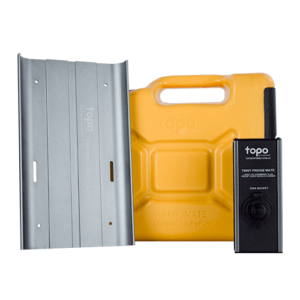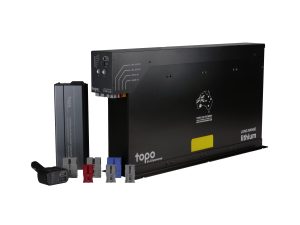So, your portable power station just blinked out… right in the middle of your camping trip or worksite shift. You’re off-grid, counting on it to power your 12V fridge, camera gear, or comms. But it’s all black now.
Frustrating, right?
These versatile gadgets are great when they work. But when they don’t, your plans can be ruined in minutes. The good news? Most issues have straightforward fixes. And we are about to teach you on all of them.
At Topo DC Power, we get how critically dependable off-grid power is. With over 40 years of experience in designing power systems built for Australia’s extremes. We’ve seen just about every issue with a portable lithium power pack.
As a proudly West Australian company, we’ve taken real user problems and engineered expert solutions. So, you can be worry-free on your every trip
What’s Inside a Portable Power Station?
For troubleshooting portable power station, you need to first understand what you’re working with. Here are the core components you’ll find in a portable power station.
1. Lithium Battery (Power Core)
Most modern power stations use a lithium camping battery. Like LiFePO4 or lithium-ion. These batterie
s are lightweight, long-lasting, and handle repeated charge cycles well. They deliver consistent DC power to your devices & last for years if maintained right.

Tinny Mate Portable Power Station
2. Inverter (Power Converter)
The inverter converts your DC battery power into AC power (the type your laptop or blender needs). So, it’s vital for compatibility with everyday appliances. Cheap inverters can struggle with high loads or spike-sensitive devices, leading to failure or unstable performance.
3. Charging Ports (Power Outlets)
From USB-C and 12V sockets to 240V AC outlets. Charging ports are the business end of your unit. They get exposed to every harsh environment of your journeys. That’s why, damaged or dirty ports are a common issue and also is easiest to overlook.

Centerfire 40a DCDC Fast Charge Dual Battery
4. Display Screen (Your Status Hub)
This digital screen displays voltage, battery percentage, and input/output details. Some models connect via Bluetooth or app for more advanced monitoring. When the screen glitches, users think the battery’s dead. But it’s usually just a communication issue.
Portable Power Station Common Issues & How to Fix Them
Repairing portable power station is not much difficult. Because mostly problems are at minor level and can be resolved with easy fixes or replacements.
1. Won’t Turn On – Is it Dead?
Portable power system is not turning on.
Possible causes:
- Battery completely drained
- System lockout from previous overload
- Power button or circuit fault
Fix:
Start with a full recharge. If that doesn’t do the trick, press and hold the power button for 10–15 seconds. Some models require a hard reset. Still no luck? Disconnect all loads & chargers, wait five minutes, then reconnect. Sometimes the internal circuit needs a breather.
2. Not Charging – Dead Battery or Just a Bad Cable?
Your portable power station is not charging via any electricity source (or solar).
Possible causes:
- Incorrect charger or adapter
- Faulty input port
- Overheat protection activated
Fix:
Use the original charger and check it’s delivering voltage. Try another power source or wall socket. If it’s still unresponsive, feel the unit. If it’s warm, let it cool before charging again. If you’ve been charging via solar, test with mains power to rule out panel faults.
3. Charges to 70%, Then Drops to Zero – What’s the Issue?
Your power station is not charging to 100% or suddenly goes to zero.
Possible causes:
- Inaccurate battery calibration
- Failing lithium cells
- Faulty BMS (battery management system)
Fix:
Do a deep cycle calibration: discharge completely, then charge to 100% uninterrupted. If it doesn’t help, means there is cell imbalance inside your lithium power pack. Some models support battery balancing via firmware. Check your manual or consult support.
4. Short Battery Life – It Used to Last All Weekend
Portable power station is getting quickly out of battery and not charging enough devices.
Possible causes:
- High-power appliances draining it quickly
- Ambient temperature affecting performance
- Ageing battery
Fix:
Reduce load by disconnecting devices that draw high amperage like kettles or heaters. Keep the unit shaded as extreme heat or cold shortens battery life. If your station’s older than 3–4 years, its capacity id naturally degrading. Replacement is due.
5. Charging Feels Like Watching Paint Dry
Your power station is taking too long to get charged.
Possible causes:
- Low output power source
- Long or cheap cables causing voltage drop
- Internal thermal throttling
Fix:
Use thick, short, high-quality cables for efficient charging. Charge with a high-wattage wall adapter or DC/DC car charger. If the unit gets hot, it’ll slow the charging to protect itself. Charging early in the day or in a cool area can speed things up.
6. Getting Too Hot – Can’t Touch This!
The power station is getting overheated during charging or discharging.
Possible causes:
- Overcharging
- Running large appliances for too long
- Sunlight exposure
Fix:
Always charge and operate in shaded or ventilated spaces. Some models have fans, make sure they’re unobstructed. If heat persists, stop use and let the unit cool naturally. Consider a dual battery setup with better heat management for high-load needs.
7. Some Devices Don’t Work with It
The portable power station is not supporting certain devices.
Possible causes:
- Device requires pure sine wave AC
- Station can’t meet peak startup power
- Voltage mismatch
Fix:
High-end electronics and fridges need a pure sine wave inverter. Check your station specs. Devices with compressors (like some camping electric battery fridges) draw high startup amps. Your station can not deliver the surge. In these cases, upgrade or add a dual battery setup for stability.
8. Devices Keep Disconnecting – Like a Bad WiFi Signal
When you put a device on charge with your power station, it keeps disconnecting.
Possible causes:
- Loose port connections
- Auto-cutoff settings kicking in
- Faulty cables
Fix:
Gently wiggle the connector. If it’s loose, you need a repair or replacement port. Power stations auto-disconnect when current draw is too low (to save battery). Try turning on another port (like the light) to keep power flowing. Swap cables to rule them out.
9. Constant Overload Warnings – Done with It!
While charging your devices, you are getting overload warnings again & again.
Possible causes:
- Running too many devices at once
- Single appliance drawing more than station’s rated wattage
Fix:
Add up the wattages of your devices & stay under the station’s output limit. If one device keeps triggering overload, test it separately. Always stagger appliance use when possible.
10. Display Errors or Bluetooth/App Glitches
The screen is not showing proper battery percentage or keep it changing.
Possible causes:
- Software bug
- Poor signal or app version mismatch
Fix:
Power cycle the station. If your model has app control, uninstall and reinstall the app. Check if firmware updates are available. Smart units include upgradable firmware to fix bugs and add features.
How Long Does a Portable Power Station Last?
On average, a quality portable lithium power pack lasts 500–2,000 charge cycles. It is roughly 3–7 years depending on use. Lifespan depends on battery chemistry, depth of discharge, and maintenance.
Lithium Iron Phosphate (LiFePO4) units last longer than standard lithium-ion. They work well especially in rough conditions.
Now, let’s move toward some tricks to enhance the battery life of your portable power station.
10 Tips to Maintain Portable Power Station for the Long Haul
Want to squeeze every drop of life from your portable power station? Here’s what you should do:
- Top it up regularly & never let the battery stay flat for too long.
- Store smart between 40–60% charging in a dry and cool place. Don’t expose it to direct sunlight or moisture.
- Clean ports regularly but gently. Blow out dust or use a soft brush.
- Don’t empty the battery charge below 20%. It will die faster from deep discharge.
- Always use a compatible charger made by a reputable manufacturer.
- Don’t place the power station with another device to prevent overheating.
- Don’t overload & respect the power limits. It’s not a wall socket.
- Keep it cool in summers & warmer in winters to maintain its performance.
- Update firmware with time to avoid bugs (if your model supports it).
- Keep swapping the faulty hardware components.
Need Tougher Camping Electric Battery for the Aussie Outdoors?
Get Rugged Power with Topo DC Power
Topo DC Power builds gear for real adventure, that don’t flake out when things get rough.
Our lithium power packs, dual battery setups, and solar-compatible systems are made in WA for harsh Aussie conditions. Whether you’re trekking across the Nullarbor or camping off-grid. Our tech keeps your 12V essentials powered and your peace of mind intact.
Power your journey, wherever it takes you.
